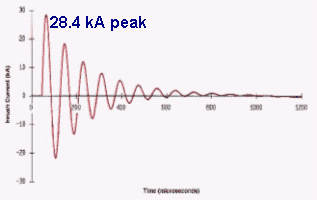Inrush current: Difference between revisions
→Transformers: Toroid transformers have up to 80 times |
|||
| Line 3: | Line 3: | ||
==Transformers== |
==Transformers== |
||
When a [[transformer]] is first energized a transient current up to 10 to |
When a [[transformer]] is first energized a transient current up to 10 to 50 times larger than the rated transformer current can flow for several cycles. (Toroid Transformers can have up to 80 times larger.) This is caused because the [[transformer]] will always have some residual [[flux density]] and when the transformer is reenergized the incoming flux will add to the already existing flux which will cause the transformer to move into saturation. Then only the copper resistance of the primary side windings are limiting the current. |
||
==Protection== |
==Protection== |
||
Revision as of 08:49, 9 February 2009

Inrush current or input surge current refers to the maximum, instantaneous input current drawn by an electrical device when first turned on. For example, incandescent light bulbs have high inrush currents until their filaments warm up and their resistance increases. Alternating current electric motors and transformers may draw several times their normal full-load current when first energized, for a few cycles of the input waveform. Power converters also feature high inrush currents relative to their steady state currents. This is typically the charging current of the input capacitance. The selection of overcurrent protection devices such as fuses and circuit breakers is made more complicated when high inrush currents must be tolerated. The overcurrent protection must react quickly to overload or short circuit but must not interrupt the circuit when the (usually harmless) inrush current flows.
Transformers
When a transformer is first energized a transient current up to 10 to 50 times larger than the rated transformer current can flow for several cycles. (Toroid Transformers can have up to 80 times larger.) This is caused because the transformer will always have some residual flux density and when the transformer is reenergized the incoming flux will add to the already existing flux which will cause the transformer to move into saturation. Then only the copper resistance of the primary side windings are limiting the current.
Protection
For example, a resistor in series with the line can be used to limit the current charging input capacitors. However, this approach is not very efficient, especially in high power devices.
Inrush current can also be reduced by inrush current limiters: negative temperature coefficient (NTC) thermistors are among the most common design options used in switching power supplies, motor drives and audio equipment to prevent damage caused by inrush current. A thermistor is a thermally-sensitive resistor with a resistance that changes significantly and predictably as a result of temperature changes. The resistance of an NTC thermistor decreases as its temperature increases.
As the inrush current limiter self-heats, the current begins to flow through it. Its resistance begins to drop and a relatively small current flow charges the input capacitors. After the capacitors in the power supply become charged, the self heated inrush current limiter offers little resistance in the circuit. So low that the voltage drop is an insignificant factor with respect to the total voltage drop of the circuit. But a Disadvantage is when switch of and after a short time on, then the NTC resistor has always a little resistance and cannot limit the inrush current. He needs a cooling time of more than 1 minute to get a higher resistance. Another disadvantage is: he is not short circuit proof.
Another element to avoid the transformer inrush current is a "transformer switching relay". It works with a short time of premagnetizing to the transformer core, by unipolare voltage-time areas. He dont need any waiting time for cool down. He can deal also with power line half-wave voltage-dips and he is short circuit proof. Important for IEC 61000-4-11 tests.
Another option, particularly for high voltage circuits, is to use a pre-charge circuit. The circuit would support a current limited precharge mode during the charging of capacitors, and then switch to an unlimited mode for normal operation when the voltage on the load is 90% of full charge.
References
- http://www.beta-dyne.com/resources/glossary.html
- Inrush Current Frequently Asked Questions
- http://www.ametherm.com/Inrush_Current/inrush_current_faq.html
- IEC 61000–4–30, Electromagnetic Compatibility (EMC) – Testing and measurement techniques – Power quality measurement methods, Published by The International Electrotechnical Commission, 2003.
- http://www.emeko.de/index.php?id=29&L=1
